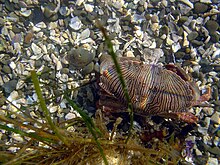
The Dungeness crab makes up one of the most important seafood industries along the west coast of North America. Its typical range extends from Alaska's Aleutian Islands to Point Conception, near Santa Barbara, California, and occasionally the crab can be found as far south as Magdalena Bay, Baja California Sur, Mexico. Dungeness typically grow 6-7 inches at their widest point and inhabit eelgrass beds and sandy bottoms. Its common name comes from the Dungeness Spit in the Strait of Juan de Fuca, Washington state, United States, which shelters a shallow bay inhabited by the crabs.

Cancer pagurus, commonly known as the edible crab or brown crab, is a species of crab found in the North Sea, North Atlantic Ocean, and perhaps the Mediterranean Sea. It is a robust crab of a reddish-brown colour, having an oval carapace with a characteristic "pie crust" edge and black tips to the claws. A mature adult may have a carapace width up to 25 centimetres and weigh up to 3 kilograms. C. pagurus is a nocturnal predator, targeting a range of molluscs and crustaceans. It is the subject of the largest crab fishery in Western Europe, centred on the coasts of the British Isles, with more than 60,000 tonnes caught annually.

Cancer is a genus of marine crabs in the family Cancridae. It includes eight extant species and three extinct species, including familiar crabs of the littoral zone, such as the European edible crab, the Jonah crab and the red rock crab. It is thought to have evolved from related genera in the Pacific Ocean in the Miocene.

Metacarcinus anthonyi, the yellow rock crab or yellow crab, is a species of edible crab native to the Pacific coast of North America.

The graceful rock crab or slender crab, Metacarcinus gracilis or Cancer gracilis, is one of only two members of the genus Metacarcinus, recognized by WoRMS, whose chelae (claws) are white tipped, the other crab being M. magister. Both of these eastern Pacific crab species are recognized by ITIS as belonging to the much larger genus Cancer. M. gracilis has been caught from Alaska to Bahía Magdelena, Baja California. Although M. gracilis is only found in the Pacific Ocean, it has cousins in the Atlantic Ocean. The genus Cancer apparently evolved in the Pacific Ocean and later migrated to the Atlantic Ocean. Larvae and small juveniles of this species are often seen riding jellyfish, especially Phacellophora camtschatica. The juvenile crabs steal food from the jellyfish and also clean off parasitic amphipods.

The giant Pacific octopus, also known as the North Pacific giant octopus, is a large marine cephalopod belonging to the genus Enteroctopus. Its spatial distribution encompasses much of the coastal North Pacific, from the Mexican state of Baja California, north along the United States' West Coast, and British Columbia, Canada; across the northern Pacific to the Russian Far East, south to the East China Sea, the Yellow Sea, the Sea of Japan, Japan's Pacific east coast, and around the Korean Peninsula. It can be found from the intertidal zone down to 2,000 m (6,600 ft), and is best-adapted to colder, oxygen- and nutrient-rich waters. It is, arguably, the largest octopus species on earth and can often be found in aquariums and research facilities in addition to the ocean.
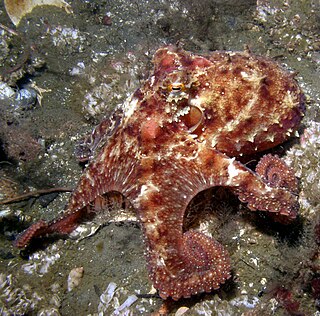
Octopus rubescens is the most commonly occurring shallow-water octopus on much of the North American West Coast and a ubiquitous benthic predator in these habitats. Its range extends from the southern Gulf of California to at least the Gulf of Alaska, but may also occur in the western Pacific Ocean. O. rubescens occurs intertidally to a depth of 300 m (980 ft).

Romaleon antennarium, commonly known as the Pacific, brown or California rock crab, is a crab of the genus Romaleon found on the western coast of North America.
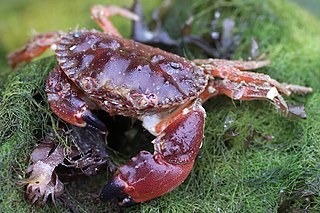
Glebocarcinus oregonensis, commonly known as the pygmy rock crab, is a species of crab found on the Pacific coast of North America.

Pagurus hirsutiusculus is a species of hermit crab, commonly called the hairy hermit crab. It lives from the Bering Strait south to California and Japan, from the intertidal zone to a depth of 110 m (360 ft).

Crab fisheries are fisheries which capture or farm crabs. True crabs make up 20% of all crustaceans caught and farmed worldwide, with about 1.4 million tonnes being consumed annually. The horse crab, Portunus trituberculatus, accounts for one quarter of that total. Other important species include flower crabs, snow crabs (Chionoecetes), blue crabs, edible or brown crabs, Dungeness crab, and mud crabs, each of which provides more than 20,000 tonnes annually.

Hemigrapsus oregonensis is a small shore crab of the family Varunidae; formerly classified under the family Grapsidae. It is known under several common names, including yellow shore crab, hairy shore crab, green shore crab, mud-flat crab, bay shore crab and Oregon shore crab. Despite its common name, the crab actually has a wide variety of coloration. It is found along the West Coast of the United States and Canada, specifically along shorelines and similar geographical areas. In 2009, H. oregonensis was included on a list of animals petitioning for the endangered species label, but there was not enough scientific information available for it to be considered as such, so it remains unevaluated to the present day.
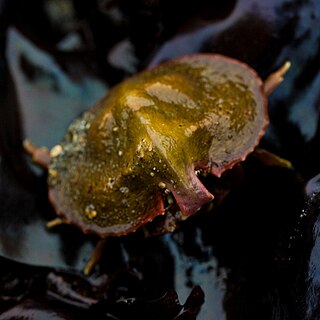
Cryptolithodes sitchensis, known as the umbrella crab, is a species of lithodid crustacean native to coastal regions of the northeastern Pacific Ocean, ranging from Sitka, Alaska to Point Loma, California. Its carapace extends over its legs such that when it pulls in its legs, it resembles a small stone. It lives in rocky areas from the low intertidal to depths of 17 m (56 ft).

Pagurus sinuatus is a large species of hermit crab found in Australia and the Kermadec Islands. It is red or orange in colour with coloured bands on the legs and patches on the body.
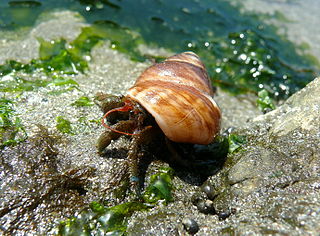
Pagurus samuelis, the blueband hermit crab, is a species of hermit crab from the west coast of North America, and the most common hermit crab in California. It is a small species, with distinctive blue bands on its legs. It prefers to live in the shell of the black turban snail, and is a nocturnal scavenger of algae and carrion.
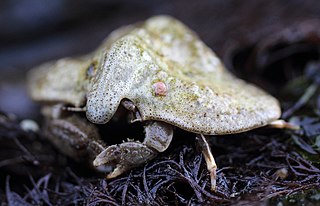
Cryptolithodes typicus, often referred to as the butterfly crab or the turtle crab, is a species of lithodid crustacean native to coastal regions of the northeastern Pacific Ocean, ranging from Amchitka Island, Alaska to Santa Rosa Island, California.

Oregonia gracilis, commonly known as the graceful decorator crab, is a species of crab belonging to the family Oregoniidae. Like other decorator crabs it habitually attaches other organisms to its back. The sessile organisms are attached to hooked setae that act as a sort of velcro attachment. This decoration provides visual and chemical camouflage thus reducing predation risk. Pacific halibut are a major predator of O. gracilis. Other predators include octopus and sea otters. The main food source of O. gracilis is floating kelp and algae that they capture utilizing a waiting strategy in order to maintain cryptosis.

Pugettia gracilis, commonly known as the graceful kelp crab, is a species of small crab in the family Epialtidae. It lives among forests of kelp on the Pacific coast of North America.
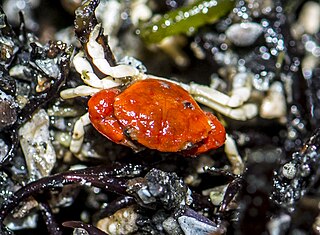
Lophopanopeus bellus, the black-clawed crab, is a species of crab in the family Panopeidae. It is native to the Pacific coasts of North America, its range extending from Alaska to California.
Carcinonemertes errans is a ribbon worm in the family Carcinonemertidae. It lives in symbiosis with the Dungeness crab, consuming the crab's developing eggs. In 1980 it was implicated in the collapse of the Dungeness crab fishery in central California.

